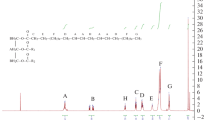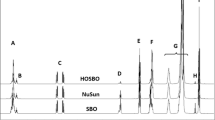Abstract
The oxidation process of soy fatty acids by sodium hypochlorite with ruthenium trichloride catalyst was examined at different temperatures and active chlorine:fatty acid molar ratios. 1H and 13C distortionless enhancement by polarized transfer nuclear magnetic resonance (NMR) spectroscopy techniques were used to monitor oxidation of the double bonds in unsaturated lipids by measuring the peak integration ratio of double-bond peaks:methylene-methyl peaks. This NMR monitoring technique proved to be an excellent means to quantify double-bond reactions. Gas chromatography-mass spectrometry was used to identify mono- and diacid products, separated by hexane/methylene chloride extraction, as well as other oxidation products. While the presence of ruthenium catalyst increased the initial rate of oxidation, it also catalyzed the decomposition of hypochlorite, decreasing the available reactive chlorine, resulting in a delay in complete oxidation. A 9:1 molar ratio of active chlorine to fatty acids completely oxidized all double bonds of soy fatty acids. However, the yield of low-molecular-weight monoacid oxidation products was only 17%, indicating the probable formation of hydroxy fatty acids.
Similar content being viewed by others
References
Nicholson, M.D., and F.M. Merritt, Cellulose Ester, in Cellulose Chemistry and Its Application, edited by T.P. Nevell and S. Haig Zeronian, Ellis Horwood Ltd., Chichester, West Sussex, England, 1985, pp. 345–346.
Wang, P., and B.Y. Tao, Synthesis and Characterization of Long-Chain Fatty Acid Cellulose Esters, J. Appl. Polym. Sci. 52:755–761 (1994).
Nippon Oil and Fats Co., Ltd, Jpn. Kokai Tokyo Koho JP 81,169,640, 26 Dec 1981.
Nippon Oil and Fats Co., Ltd, Jpn. Kokai Tokyo Koho JP 82 04,940, 11 Jan 1982.
Nippon Oil and Fats Co., Ltd., Jpn. Kokai Tokyo Koho JP 82, 07, 437, 14 Jan 1982.
Zaidman, B., A. Kisilev, Y. Sasson, and N. Garti, Double Bond Oxidation of Unsaturated Fatty Acids, J. Am. Oil Chem. Soc. 65:611–615 (1988).
Schraml, J., and J.M. Bellama, Homonuclear Chemical Shifts Correlated Spectra (COSY), in Two-Dimensional NMR Spectroscopy, John Wiley & Sons, Inc., New York, 1988, p. 97.
Kemp, W., NMR in Chemistry: A Multinuclear Introduction, Macmillan Publishing Co., New York, 1988, p. 143.
Standard Methods for the Examination of Water and Wastewater, American Public Health Association, Inc., Washington, D.C., 1960, pp. 81–85.
Kyriakidis, N.B., and G. Dionysopoulos, Preparation of Fatty Acid Methyl Esters from Olive Oil and Other Vegetable Oils Using Aqueous Hydrochloric Acid-Methanol, Analyst 108:738–741 (1983).
Fatty Acids and Their Industrial Applications, edited by E. Scott Pattison, Marcel Dekker, Inc., New York, 1968, p. 6.
Macomber, R.S., in NMR Spectroscopy, Basic Principles and Applications, Harcourt Brace Jovanovich, San Diego, 1988, pp. 72–76.
Author information
Authors and Affiliations
Corresponding author
About this article
Cite this article
Wang, P., Tao, B.Y. Soy fatty acid oxidation with sodium hypochlorite monitored by nuclear magnetic resonance spectroscopy. J Amer Oil Chem Soc 75, 9–14 (1998). https://doi.org/10.1007/s11746-998-0002-2
Received:
Accepted:
Issue Date:
DOI: https://doi.org/10.1007/s11746-998-0002-2




